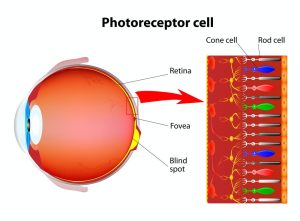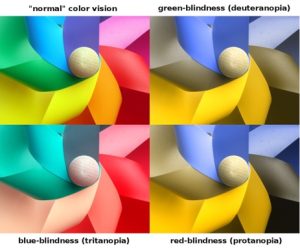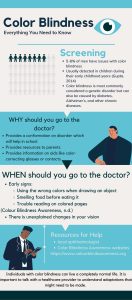Sophie Gardner
What is Color Blindness?

Color blindness is a disorder that makes it hard for individuals to see different colors. It might also cause people to not be able to see bright colors or different types of the same color. Color blindness occurs when there is an issue with how the eyes view colors. This is because the receptors in the eyes, called cones, do not work correctly. The most common type of color blindness is when it is hard to see differences between greens and reds. There are also cases when people cannot see differences between blues and yellow (National Institutes of Health: National Eye Institute, 2019).
Color Blindness Statistics
Color blindness most commonly affects males due to genetics. Genes are found on chromosomes and hold an individual DNA material. Males have an X and a Y chromosome while women have two X chromosomes. A male only needs to have an error in his X chromosome for there to be a development of a disease. In a female, they would have to have errors on both of their X chromosomes (Haldeman-Englert et al., n.d.). Five to eight percent of men in the world have issues with color vision while only one percent of females have issues with color vision (Melillo et al., 2017). If a mother has color blindness, the chances that her son also has color blindness is very high because the female passes the disorder on her X chromosome. In a study conducted, color blindness is most common in non-Hispanic white boys (5.6%) It is the least common for Black boys (1.4%) with Asian children (3.1%) and Hispanic children (2.6%) ranking in the middle (Xie et al., 2014).

Detection and Causes
Color blindness is usually detected in children during their early school years. It is not until children are learning the names of colors that color blindness is noticed (Gupta, 2014). Early signs of color blindness in school include using the wrong colors when drawing an object, smelling food before eating it, or trouble reading with colored pages (Colour Blindness Awareness, n.d.-a). Only an eye doctor (known as an opthalmologist) can determine if someone has the condition. However, here is an online screening tool if someone suspects he may be color blind.
https://www.eyeque.com/color-blind-test/test/
© 2021 EyeQue Corporation
Besides being born with color blindness, it can also be caused by other conditions like Alzheimer’s, and other chronic diseases. It is not uncommon for color blindness to get better once the inflicted disease gets managed or treated. Diabetes can cause color blindness because diabetes can cause damage to the back of the eye, where the cones in the eye are located (Kadrmas Eye Care New England, 2018). Alzheimer’s disease can cause issues with color blindness due to the eye’s inability to recognize or differentiate different colors. Color blindness can also be caused by aging and exposure to harmful chemicals later in life (Mayo Foundation for Medical Education and Research, 2019). The video below explains how color blindness can affect an individual.
https://www.webmd.com/eye-health/video/what-colorblindness-looks-like
©2016, WebMD, LLC. All rights reserved
Living With Color Blindness
Depending on what part of the world a color-blind individual lives in, society views their condition differently. In the United Kingdom, color blindness is not considered a disability. In Japan, color blindness is a defect (Colour Blindness Awareness, n.d.-b). Japanese individuals with this condition are not allowed to perform certain jobs and sometimes are not even allowed to drive a car. In other countries, like the United States, color blindness is treated as a disability and must be addressed the same as other disabilities (Colour Blindness Awareness, n.d.-b).
In contrast, individuals with color blindness can live a completely normal life. Certain jobs might be more difficult for them. An electrician working with different colored wires would have difficulties if they were color blind (Colour Blindness Awareness, n.d.-b). While driving, an individual with color blindness might focus on the pattern of the stoplights rather than the colors. Instead of the green light meaning “go”, they would recognize that the bottom light means “go.” A color-blind individual might not be able to notice social cues of another person’s mood changing due to the color of their face. They might not be able to notice their child being sunburnt or if their meat is cooked thoroughly. There have been instances where individuals have not been diagnosed with color blindness and then go on to not pass a vision test for their desired job. It can result in personal distress and sadness that could have been avoided if they were diagnosed earlier in life (Colour Blindness Awareness, n.d.-b). Research on this topic has been limited, therefore there is a small number of support options for these men. Color blindness awareness needs to be increased so that people with it can get the help and support that they need.
Management of Color Blindness
Currently, there are ways to help individuals with color blindness see colors. There are glasses and contact lenses that people can use that will help their eyes absorb colors correctly. The glasses and contact lenses are specific to what type of color blindness affects the individual. An individual with color blindness will not be cured with glasses or contact lenses but they will be able to see the different colors better than they did before (Salih et al., 2020).

The above infographic can help an individual through the process of determining if they might be color blind and what steps should be taken.
Chapter Review Questions
1. Why are men more likely to be color blind?
A. Women are exposed to color differentiation in daily life more often than men, so they have more practice
B. Men only have one X chromosome so if there is a gene for color blindness on the X, it will affect the individual
C. Men are more likely to perform risky behavior, therefore, increasing their risks of injury
D. Women do not have an X chromosome, so they are less likely to have the colorblind gene in their DNA.
2. What is the most common type of color blindness?
A. Red-green
B. Blue-yellow
C. Red-blue
D. No color- just black and white
3. What job will an individual with color blindness have the most difficulty performing successfully?
A. Truck driver
B. Electrician
C. Artist
D. Teacher
References
Ahlmann, J. (2011, September 14). Simulation of different color deficiencies, color blindness. Flickr. https://www.flickr.com/photos/entirelysubjective/6146852926
Colour Blind Awareness. (n.d.-a) Early symptoms. https://www.colourblindawareness.org/parents/early-symptoms/
Colour Blind Awareness. (n.d.-b) Living with colour vision deficiency. https://www.colourblindawareness.org/colour-blindness/living-with-colour-vision-deficiency/
EyeQue. (n.d.). Color blind test. https://www.eyeque.com/color-blind-test/test/
Gupta, R. C. (2014, August). Color blindness factsheet (for schools). KidsHealth from Nemours. https://kidshealth.org/en/parents/color-blind-factsheet.html?ref=search#cateyes
Haldeman-Englert, C., Freeborn, D., & Turley, R. K. (n.d.) X-linked inheritance: red-green color blindness, hemophilia. University of Rochester Medical Center. https://www.urmc.rochester.edu/encyclopedia/content.aspx?ContentTypeID=90&ContentID=P02164
Kadrmas Eye Care New England (2018, June 5). Alzheimer’s & eyesight: Is there a connection? http://www.kadrmaseyecare.com/eye-health–care-blog/alzheimers-eye-sight-is-there-a-connection-alzheimers-brain-awareness-month
Martin, P. (2018, December 18). Curious kids: Why are people colour blind? The Conversation. https://theconversation.com/curious-kids-why-are-people-colour-blind-107599
Mayo Foundation for Medical Education and Research. (2019, December 28). Color blindness. Mayo Clinic. https://www.mayoclinic.org/diseases-conditions/poor-color-vision/symptoms-causes/syc-20354988?utm_source=Google&utm_medium=abstract&utm_content=Color-blindness&utm_campaign=Knowledge-panel.
Melillo, P., Riccio, D., Di Perna, L., Sanniti Di Baja, G., De Nino, M., Rossi, S., Testa, F., Simonelli, F., & Frucci, M. (2017). Wearable improved vision system for color vision deficiency correction. IEEE Journal of Translational Engineering in Health and Medicine, 5, 1–7. 10.1109/JTEHM.2017.2679746
National Institutes of Health: National Eye Institute (2019, July 3). Color blindness. https://www.nei.nih.gov/learn-about-eye-health/eye-conditions-and-diseases/color-blindness
Salih, A. E., Elsherif, M., Ali, M., Vahdati, N., Yetisen, A. K., & Butt, H. (2020). Ophthalmic wearable devices for color blindness management. Advanced Materials Technologies, 5(8), 1901134. https://doi.org/10.1002/admt.201901134
WebMD. (2017, July 20). Colorblindness video: What color blindness looks like [Video]. https://www.webmd.com/eye-health/video/what-colorblindness-looks-like.
Xie, J. Z., Tarczy-Hornoch, K., Lin, J., Cotter, S. A., Torres, M., & Varma, R. (2014). Color vision deficiency in preschool children. Ophthalmology, 121(7), 1469-1474. 10.1016/j.ophtha.2014.01.018
the study of how genetic material (DNA) can be passed down from parents to their offsprings
